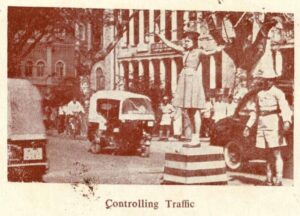Bengaluru’s transformation is a tale of resilience, adaptation, and complexity. While it embraces its identity as a modern tech city, the historical soul persists through its bustling markets, heritage sites, and age-old traditions.
Published Nov 16, 2024 | 9:00 AM ⚊ Updated Nov 16, 2024 | 9:00 AM

Bruhat Bengaluru Mahanagara Palike. (South First)
Bengaluru’s roots trace back to around 890 AD, as suggested by the old-Kannada stone inscriptions at the Nageshwara Temple in Begur.
By 1537, the city’s modern foundation was laid by Kempe Gowda, a visionary under the Vijayanagara Empire, who built a mud fort that became the heart of thriving market areas, or petes.
The fall of the Vijayanagara Empire in 1565 saw Kempe Gowda I declaring independence, and his successor, Kempe Gowda II, delineated the city’s boundaries with four iconic towers.
In 1638, the city faced conquest by the Adil Shahi Bijapur army, and under Shahaji Bhonsle’s leadership, Bengaluru underwent a reconstruction, and lakes were created to address water shortages. The Mughals sold the city to Chikkadevaraja Wodeyar, who incorporated it with the Kingdom of Mysore.
The 18th century witnessed significant shifts when the British East India Company captured Bengaluru during the Third Anglo-Mysore War (1791).
The Fourth Anglo-Mysore War (1799) cemented their power, and in 1809, the British established a cantonment northeast of the city, introducing a unique duality: the traditional, Kannada-speaking pete and the cosmopolitan British cantonment.
The two areas maintained separate administrations until their unification under the Bangalore City Corporation in 1949.
History researcher Dharmendra Kumar, said, “Bengaluru’s twin-city structure contributed to its rich, layered identity, blending local and colonial influences seamlessly.”
Historically a melting pot, Bengaluru’s post-independence era solidified its position as the capital of the newly named Karnataka state in 1973.
The influx of people from across India led to a unique blend of cultures. Early settlers embraced Kannada, integrating seamlessly. However, recent trends show a divide: newcomers, drawn by educational and job opportunities, often remain detached from local culture.
“Unlike earlier days, many migrants now believe the city is largely composed of outsiders, which is a misconception,” Kumar noted. This shift has affected the city’s linguistic and social dynamics.
“Language imposition was never a significant issue 20-30 years ago,” Kumar said. However, recent waves of migrants often bypass learning Kannada, mistakenly believing the city is predominantly composed of outsiders.
“Engaging with local transport workers, shopkeepers, and neighbourhood communities in Kannada enriches the connection to the city,” Kumar emphasised. Learning Kannada isn’t just a gesture; it’s a bridge to understanding Bengaluru’s cultural soul.
The boom in higher education and IT jobs gave rise to Bengaluru’s PG (paying guest) culture. Areas like Koramangala, Whitefield, and HSR Layout teem with PG accommodations that host thousands of young professionals and students.
This phenomenon has shaped local economies, supporting food services, transport, and recreational businesses.
However, it has also led to concerns over congestion and strained infrastructure.
One cannot discuss Bengaluru without acknowledging its traffic. Known for being one of the most congested cities in the world, commuting can often be a daunting task.
The city’s rapid expansion, combined with narrow roads and an ever-growing population, has tested its infrastructure.

A 1964 photograph of a Ranger from Mount Carmel College, Bangalore, undergoing Traffic Control Training and managing traffic.
Credit: Mount Carmel College Annual 1964, gpura.org Digital Archives.
While initiatives like the metro expansion aim to alleviate this issue, the pace of change has struggled to match the city’s growth.
Despite its challenges, Bengaluru has risen as India’s technology capital, home to startups, tech giants, and a vibrant entrepreneurial ecosystem.
The city is synonymous with innovation, drawing talent from across the globe. The once-quiet gardens of Lal Bagh and Cubbon Park now contrast with the gleaming skyscrapers of Electronic City and Whitefield.
“Bengaluru’s resilience is evident in its evolution from a modest trading town to a global hub,” Kumar said.
Bengaluru’s transformation is a tale of resilience, adaptation, and complexity. While it embraces its identity as a modern tech city, the historical soul persists through its bustling markets, heritage sites, and age-old traditions.
The challenge for Bengaluru lies in harmonising growth with preservation, ensuring that its story continues to reflect both its storied past and its dynamic present.
Amidst traffic jams, high-rise buildings, and the constant hum of innovation, the city’s spirit remains timeless—a testament to its history, culture, and people.
(Edited by Majnu Babu).
